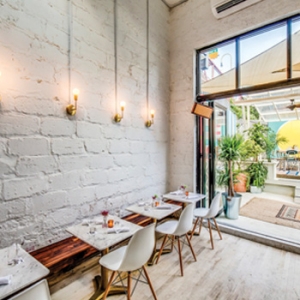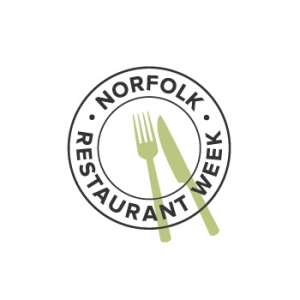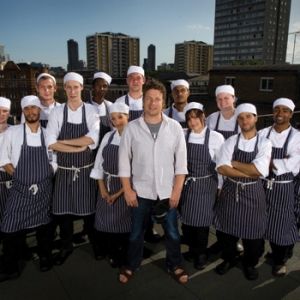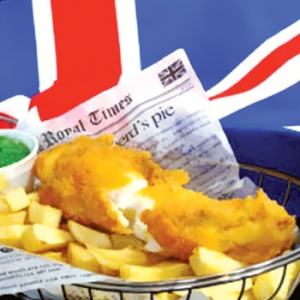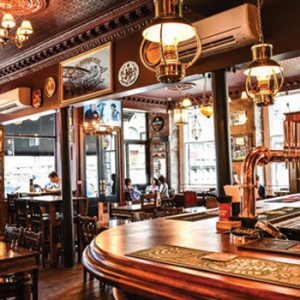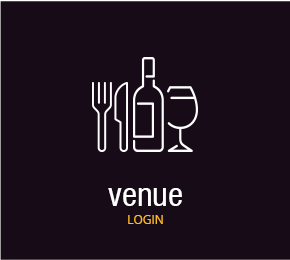Restaurants are only getting smaller, and that's by design
With fewer customers eating at restaurants, operators are eyeing more compact locations with dedicated areas for takeout orders.
Restaurants are shrinking. Even though more people are eating out than before, fewer are sticking around to eat their meal in store. With this shift, brands from Firehouse Subs to McDonald's and Dunkin' to Pizza Hut are rethinking design for both front- and back-of-house to better accommodate delivery and takeout — a strategy that often includes smaller formats.
When considering design, restaurants traditionally focused on minimum guest count and maximizing seats in a dining room, but these conversations are changing, Big Red Rooster Senior Vice President and Managing Director Josh Broehl told Restaurant Dive. Big Red Rooster is a JLL company that works with retailers and restaurants on experience design, brand marketing, design management and strategy consulting.
"It's now about throughput. It's now about how many customers can we serve," he said.
With multiple avenues to reach customers from delivery to mobile order pickups, there's less need for a dining room, he said. There's also financial incentive to reduce — or forgo — the physical dining space. Broehl estimates that dine-in now accounts for about 15% of a typical restaurant's sales compared to several years ago, when it was roughly 40%.
Restaurants are also analyzing customer traffic flow more closely to accommodate those that want to dash inside for pickup as well as others who want to mull over a menu and then decide onsite, Broehl said.
"We need to make sure those pathways are intuitive and easy, avoiding the bottlenecks," he said.
Restaurant design is starting to incorporate different zones where third-party deliveries can do pickups or wait for fulfillment of orders, he said.
"Delivery is a must-have these days," Pamela Flora, director of Americas retail research at Cushman & Wakefield, told Restaurant Dive. "How are [restaurants] balancing delivery prep space versus dining space? Do they have easy access for third-party pickups?"
Mobile orders fulfilled onsite are being brought toward the front for quick pickups and are separate from onsite ordering and dining, Broehl said. Shelves and lockers are increasingly popular as well, with the likes of Chipotle, Blaze Pizza and Cava adding shelves. While there were originally concerns about theft or tampering of food left on shelves, that has yet to emerge as a problem, Broehl said.
"Delivery is a must-have these days. How are [restaurants] balancing delivery prep space versus dining space? Do they have easy access for third-party pickups?" - Pamela Flora - Director of Americas retail research, Cushman & Wakefield
Needing less dine-in space is opening up options for restaurants. They don't need to spend as much on real estate costs and can instead use inline spaces within a retail block instead of a standalone location, Broehl said.
"You'll continue to see that trend where restaurants can take advantage of these more flexible spaces, which will definitely help their operating costs," he said.
While dining rooms are decreasing in size, kitchens are growing due to the addition of digital orders, he said. That often means having multiple makelines. Previously, there may have been a makeline for dine-in and drive-thru orders, but now some QSRs with drive-thrus are even adding a third makeline to accommodate mobile orders, Broehl said.
For an independent restaurant like fast casual Bamboo Asia in San Francisco, many of these design concepts, including a small footprint, were part of the plan from the beginning. The restaurant uses a commissary kitchen to prepare much of the Vietnamese, Japanese and Indian dishes that make up its menu offsite, and a sous vide to heat onsite. This allows for a smaller kitchen without heavy equipment, TRI Commercial Restaurant Specialist Erik Reese told Restaurant Dive. He has helped conceptualize restaurants, including Bamboo Asia, throughout his 20-year career in the industry.
The 1,800-square-foot restaurant only has 30 seats inside and eight outside, and most of its business is off-premise, he said. The restaurant serves about 550 customers between 11 a.m. and 2 p.m.
With less real estate needs, the restaurant was able to relocate in a prime area of downtown San Francisco, where retail rents are $450 per square feet, according to Cushman & Wakefield data.
"It really reduces our labor demands and allows us to get spaces that other companies can't take," he said.
Its location on a popular downtown intersection also serves as a marketing tool for the thousands of drivers who pass by, he said.
"The whole restaurant is an advertisement," he said.
The company is adding 12 more locations by the end of 2020 and plans to open another commissary kitchen, all of which will be built around the idea that around 25% of the business going toward delivery, he said.
A new QSR model
Major QSRs are taking cues from delivery and carryout trends as well. Fast casuals including Cava, Blaze Pizza and Chipotle are testing out drive-thrus for mobile pickup orders. Others, like Firehouse Subs, Subway, Dunkin', McDonald's and Caribou Coffee, are eyeing complete remodels and smaller store formats.
Firehouse Subs is testing a prototype that would be a dramatic design shift for the brand. It uses 25% less kitchen space and holds 28 seats compared to a traditional design of 50 seats.
The design also moves the kitchen from the front to back of the restaurant to better accommodate pickups, which have its own designated area. A stackable sandwich steamer, new to the prototype, helps reduce heating time by a minute, and CEO Don Fox told Restaurant Business the new prototype could result in one less person needed each shift.
Firehouse Subs has plenty of motivation to move toward this model. Its off-premise business now makes up more than half of its sales, according to Restaurant Business.
While McDonald's is in the midst of a major renovation across its U.S. system that will add self-order kiosks, it is also testing a McDonald's To Go format in London. Customers order using kiosks, staff is mainly back of house and there is no seating. The concept is meant to accommodate only diners on the go.
Pizza Hut is piloting cubbies for pickup orders in California and plans to expand the test into additional West Coast cities next year. These cubbies, aimed to complement its dine-in experience, are placed toward the front of the store and are meant to appeal to customers on-the-go who don't want to interact with restaurant staff. These moves seem to align with the company's recently announced strategy of closing 500 units and reopening them with its delivery and carryout-focused format that offers less dine-in seating.
Caribou Coffee is rolling out a small-format concept in Minnesota called Caribou Cabins. These 600-square-foot stores don't have any dine-in seating, but offer outdoor seating, a drive-thru and a walk-up window. The Cabin stores will offer an expanded beverage menu and a selection of breakfast sandwiches and baked goods. Caribou Coffee is looking to add more locations within the next 24 months, with five opening up in Minnesota initially. The chain will also explore additional store formats in urban and suburban areas.
There could be even more design changes ahead for the dining experience as diner demand shifts.
"Restaurants are working to bring the dining experience to customers when and where they are," Broehl said.
Instead of being tied to a set kitchen, restaurants could potentially serve up meals in a local park or food hall or other community experience, he said. Several chains like Auntie Anne's and Shake Shack have already done so by launching fleets of food trucks and opening locations at airports and travel plazas.
For consumers, it will only become easier to order out — exactly what restaurants need.
Norfolk Restaurant Week - 28th Oct 2019 to 8th Nov 2019
There's more choice than ever before this year with more than 80 businesses in the county offering discounted menus.
More restaurants than ever before have signed up to this year's Norfolk Restaurant Week and sister event, Norwich Restaurant Week, with organiser Martin Billing saying it will be the best one yet.
Now in its seventh year and billed as the largest dining event in the county, the foodie feasting takes place between October 28 and November 8, with more than 80 of Norfolk's top restaurants, pubs and cafes signed up to participate.
Newcomers this year include The Victoria in Holkham, plant-based Erpingham House in Norwich, The Black Horse in Castle Rising, Timbers Country lodge in Fincham, Sculthorpe Mill and The Iron House, Norwich.
Loui Blake, owner of Erpingham House says: "We're incredibly excited to be participating in Norfolk restaurant week for the first time. Our intention is to offer diners some never-before-seen dishes and offer an insight into plant-based dining, proving healthy and sustainable food can be delicious! We're seeing a dramatic spike in the demand for vegan food, with Norwich often quoted as one of the best hubs nationally. We hope through restaurant week we can offer local diners a taste of something to inspire them."
Ben Hunter-Watts, The Victoria's managing director adds: "Michael Chamberlain, our head chef, has participated in Norfolk Restaurant Week in his previous position prior to taking on the running of the kitchen here at the Victoria. He is excited to have the opportunity to this year showcase the fantastic local and estate raised produce he is so passionate about using here at the Vic on his restaurant week menu."
During the period of the event (actually two weeks), all businesses taking part will offer set, discounted menus, giving diners in the region the chance to perhaps explore eateries they might not have considered before. Customers will have the option (depending on where they're dining) to pay £12 for two courses or £17 for three, or £18 for two and £23 for three.
It's estimated more than 1,000 people book a stay to coincide with Norfolk Restaurant Week which is why the county's largest independent holiday lettings agency, Norfolk Cottages, has signed up to be headline sponsor for the second year running.
"We know that Norfolk's reputation for outstanding local produce and a rich food and drink scene is one of the reasons our discerning customers choose the county as a holiday destination. We also see a 15% increase in visitor numbers over the fortnight, further demonstrating the fact Norfolk is a year-round destination.
See all the businesses taking part here.
A glimpse at some of the menus
NoTwenty9, Burnham Market
Starters include: cured sea trout with gin and tonic gel, pickled vegetables and Paston Acre sprouting rye bread, and 'ham, egg and chips' - pork terrine with fried quail's egg and matchstick potato
Main courses include: fillet of hake with Creole sauce, coconut rice and kale, and shallot and celeriac tarte tatin with walnut and fig salad
Desserts include: baked chocolate mousse, blackberry ice cream and chocolate crumb, and pecan pie with pecan brittle and raw milk ice cream
Over 1,400 UK restaurants close due to casual dining crunch bites
Insolvencies in year to the end of June 2019 increased by 25% – the highest since at least 2014
More than 1,400 UK restaurants collapsed in the year since June 2018 – underlining the scale of the so-called “casual dining crunch”, which has led to customers turning their backs on chains such as Byron, Strada, Gourmet Burger Kitchen and Jamie Oliver’s restaurant empire.
The number of restaurants falling into insolvency in the year to the end of June 2019 increased by 25% to 1,412 compared to 2018, according to research by the accountancy firm UHY Hacker Young. It is the highest number of insolvencies since at least 2014 and is said to reflect tightened consumer spending on the back of concerns about Brexit and rising costs because of the collapse in the value of the pound.
UHY Hacker Young said the rapid growth of the casual-dining sector since the 2008 financial crisis had resulted in an oversaturated mid-market, which is still going through a dramatic shakeout. The research found that hundreds of small independent restaurants had collapsed as well as big chains such as those owned by the celebrity chef Oliver.
“The crisis in the restaurant sector has been presented as a problem only for the chains that had lost touch with their customers,” Peter Kubik, a partner at UHY Hacker Young, said. “That’s overlooking the hundreds of small independent restaurants that have become insolvent.
“Good restaurants and bad have all struggled from overcapacity, weak consumer spending and surging costs. Having a loyal following is great but if that loyal following stops going out then you have a problem. The number of restaurants whose sales are at or near capacity is pretty small – they’re the exception.”
Experts predict that after the shakeout only restaurants with strong brand loyalty and a differentiated offering will survive.
“For those businesses that are suffering distress, aggressive management of cashflow will be key in the coming months,” Kubik said. “Unfortunately, the sector can’t really expect banks to be as generous with their lending, especially as the sector’s current problems are so well known.”
The research also found that the UK’s top 100 restaurants made a £82m loss in the last year, down from a pre-tax profit of £102m 12 months earlier.
Birds Eye creates 'children-only' restaurant
Birds Eye has created a "children-only" restaurant serving vegetable-based dishes in a fun environment.
The pop-up in Holborn, London, is part of Birds Eye’s new TV campaign, "Eat in full colour", created by Grey London.
The "First-Plates" restaurant will use normal ingredients but serve them in a alternative way to encourage children to eat healthier foods. Dr Elizabeth Kilbey, from Channel 4’s The Secret Life of 4, 5 and 6 Year Olds, will take charge of the session of how to navigate picky eaters and get the whole family consuming a wider variety of foods.
Targetting children aged four to seven, a balloon artist who will create a colourful balloon vegetable for each child will be part of the entertainment as well as an interactive play zone featuring a garden pea ball pit
The two-hour ticketed event, taking place on 21 September, includes a welcome drink and sit-down lunch for children, and snacks for adults. Parental supervision is required.
Britain’s top 10 fish and chip restaurants revealed
BRITAIN'S ten best fish and chip restaurants have been revealed - but did your local make the cut?
The finalists for the Fish and Chip Restaurant of the Year Award are now patiently waiting to see who will win the top prize at Seafish's 2020 National Fish & Chip Awards.
This award celebrates "true excellence" in the fish and chip industry, judging 100's of fish and Chip Restuarants nationally.
Each restaurant is being assessed on sustainable sourcing, menu innovation, marketing, staff training and customer service as well as taste!
The top ten finalists will be put into a final round of judging in London in January 2020 where the winner to be announced.
The restaurant award is open to all UK Fish & Chip Restuarants with a sit-in facility at the main location.
fish! - Borough Market, London
Fish! sits in the centre of London's high end Borough Market - and diners can watch their fish being cooked in real time.
Chefs source produce locally from nearby stands and stalls, while fish is delivered daily from their very own fishmonger.
The menu offers a wide selection of beer-battered fish. This offers punters the option of cod, haddock, plaice or hake.
Fish City - Belfast
Fish city has already won a slew of awards - including Regional Fish and Chip Shop of the Year in 2015.
It was set up as a family business in 2013 and only offers sustainable seafood.
Diners can also delve into oysters or fish tacos.
Knights Fish & Chip Restaurant - Glastonbury, Somerset
Knights has been going for over 100 years - it served its first meal in 1909.
The business has stayed in the family ever since, and offers a vast range of classic dishes.
Mushy peas can be ordered with curry sauce for those who want a bit of a kick, with a range of local beers available on the side.
Malt and Anchor - Cirencester, Gloucestershire
The Malt and Anchor has only been going since 2017 - but has already established a solid reputation in the heart of the Cotswolds.
It offers what it claims is a 'traditional chippy menu with a twist' as well as a takeaway service.
The lunch menu runs from 12 until 2.20pm, and also hosts Christmas parties.
Quayside Restaurant & Fish Bar, Gourdon, Aberdeenshire
Diners at Quayside can eat freshly-caught local fish with amazing views of the Gourdon Harbour and North Sea.
Staff also keep a specials board filled with fresh produce from the local area.
Saltwater Fish Restaurant - Torquay, Devon
Saltwater Fish Restaurant sits a stone's throw from Torquay's picturesque harbourside.
It offers everything from fish to burgers, as well as a 'catch of the day' special.
Something Else Fishy - Sherborne, Dorset
Martyn and Nicki Else were fishmongers for ten years before deciding to open a restaurant instead.
Aside from classic fish and chip shop fare, they offer lobster, mussels, and 'drunken prawns' - king prawns cooked in Jack Daniels.
The Cods Scallops - Nottingham, Nottinghamshire
The Cods Scallops also made the Top 20 list for Fish and Chip shops.
It offers a wide selection of fish and shellfish, all of which are caught from their very own boats.
They also serve sustainable crab, cockles, and lobster.
The Fisherman’s Wife - Whitby, North Yorkshire
The Fisherman's Wife offers stunning views of Whitby Bay and the surrounding area.
The team has more than 50 years' experience and boasts "the best from the sea and the finest produce from the fields of Yorkshire."
All fish is selected from a local fish market, while crab and lobsters are caught from the local bay.
Scottish Pub Group looks for £20m for Expansion
A Scottish independent pub group is seeking to raise £20m to fund its expansion through acquisitions.
Edinburgh-based Bruce Group Scotland, which owns 19 pubs in and around the capital, is issuing a bond to fund growth over the coming few years.
Bruce group was founded in 1999 by Kevan Fullerton and Scott Piatkowski.
Its portfolio of bars, clubs and music venues include the George IV Bar, Royal Mile Tavern, La Belle Angele and Whistlebinkies.
The Bruce Group explained it was looking at expanding after having a "considerable growth" in recent years.
Mr Fullerton said: "We believe that the pub market currently offers excellent potential for growth and profitability and we have the scale, expertise and knowledge of the market to expand substantially in a relatively short timescale. We think that our model, extended across Edinburgh and into Glasgow and the central belt, will produce a profitable pub group which, although centrally owned and operated, retains the individual identity and character of each pub. We are not creating a chain, we are building a group of individual pubs which nonetheless benefit from experienced management, strong financial backing, and the cost savings which a large group can command."
The bonds of the subsidiary of the Bruce Group, Bruce Pubs plc, are being traded on the NEX Exchange Growth Market.

 find your venue
find your venue feature your venue
feature your venue